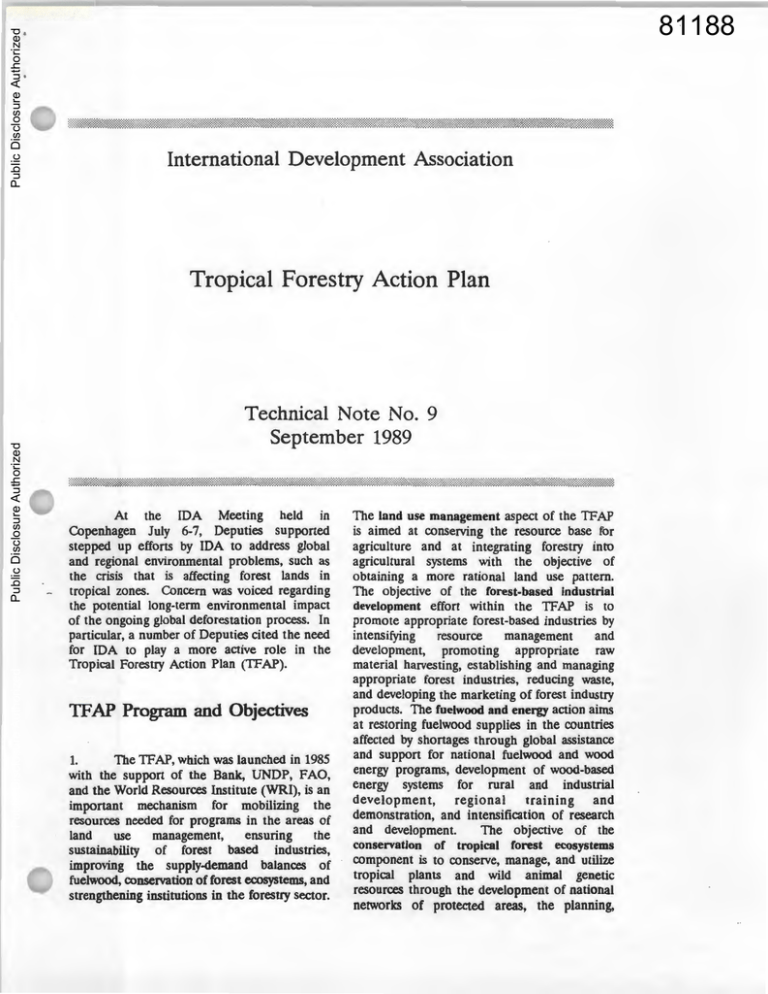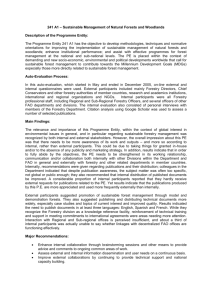81188 Tropical Forestry Action Plan
advertisement

Public Disclosure Authorized Public Disclosure Authorized Public Disclosure Authorized Public Disclosure Authorized 81188 International Development Association Tropical Forestry Action Plan Technical Note No. 9 September 1989 At the IDA Meeting held in Copenhagen July 6-7, Deputies supported stepped up efforts by IDA to address global and regional environmental problems, such as the crisis that is affecting forest lands in tropical zones. Concern was voiced regarding the potential long-term environmental impact of the ongoing global deforestation process. In particular, a number of Deputies cited the need for IDA to play a more active role in the Tropical Forestry Action Plan (TFAP). TFAP Program and Objectives 1. The 1FAP, which was launched in 1985 with the support of the Bank, UNDP, FAO, and the World Resources Institute (WRI), is an important mechanism for mobilizing the resources needed for programs in the areas of land use management, ensuring the sustainability of forest based industries, improving the supply-demand balances of fuelwood, conservation of forest ecosystems, and strengthening institutions in the forestry sector. The land use management aspect of the 1FAP is aimed at conserving the resource base for agriculture and at integrating forestry into agricultural systems with the oejective of obtaining a more rational land use pattern. The objective of the forest-based industrial development effort within the 1FAP is to promote appropriate forest-based industries by intensifying resource management and development, promoting appropriate raw material harvesting, establishing and managing appropriate forest industries, reducing waste, and developing the marketing of forest industry products. The fuelwood and energy action aims at restoring fuelwood supplies in the countries affected by shortages through global assistance and support for national fuelwood and wood energy programs, development of wood-based energy systems for rural and industrial development, regional trammg and demonstration, and intensification of research and development. The objective of the conservation of tropical forest ecosystems component is to conserve, manage, and utilize tropical plants and wild animal genetic resources through the development of national networks of protected areas, the planning, Page 2 management and development of individual protected areas, and research into the management of tropical forests for sustainable production. And finally, the institution strengthening objective of the TFAP is to remove the institutional constraints impeding the conservation and wise use of tropical forest resources by strengthening the public forest administrations and related government agencies, integrating forestry concerns into development planning, providing institutional support for private and local organizations, developing professional, technical and vocational training, and improving extension and research. 2. TFAP entails both multi-donor forestry sector review missions in specific countries and global initiatives. The country specific forestry sector review missions and follow-up project implementation work constitute the core effort of the TFAP. At the same time, the global initiatives aim to provide a forum for continued exchange of information and a mechanism for action on issues and opportunities of key importance to the TFAP. 3. These global initiatives involve international conferences where forestry and the environment are discussed within a global context. They have in the past led to the formation of task forces to investigate specific issues of mutual concern and to make recommendations as appropriate. One such conference was held in Bellagio out of which emerged a forestry research task force which reported its findings and recommendations to the subsequent Bellagio II conference. As a result of this work, it has now been agreed that forestry will be included in the CGIAR system. 4. The aim of the country forestry sector review missions are to ensure that the appropriate forestry policies, land tenure arrangements, and fiscal changes needed to sustain the forestry and environmental sectors are identified and implemented. These missions are initiated at the request of respective governments to the TFAP Coordination Unit, which then identifies an agency who agrees to act as mission leader and organizes the participation of other donors and inputs. The joint mission then usually involves a forestry sector review which explores the issues and consolidates information to facilitate strategy planning and project identification. This exercise is then followed by 'round-table meetings' which bring together NGOs, the private sector, the donor community, and government to discuss the national forestry issues and to agree on areas of priority and further work. On this basis, a long-term (20year) forestry sector strategy and plan is developed from which a medium-term (5-year) action plan is prepared. Although these missions and related subsequent work have resulted in reports which identify possible projects, they have not prepared these projects to the point where they are "bankable". 5. The TFAP missions are generally led and funded by various donors. The key donors are: United Nations Development Programme (UNDP), Food and Agriculture Organization (FAO), the Bank, The Regional banks, the European Economic Community, and a large number of bilateral donors. 6. So far, sixty two countries have requested TFAP assistance. Out of these, twenty one sector review missions have been completed and another thirty three are at various stages of implementation and report preparation. In addition, six of the follow-up round table meetings have been held so far. The detailed status of implementation of the TFAP program is provided in the table above. Bank Participation 7. Of the twenty one completed TFAP sector review missions, the Bank has led four of them: Ghana, Kenya, Sudan, and Papua New Guinea. The Bank has also participated as a team member in four of the completed missions: Cameroon, Colombia, C6te d'lvoire, and Tanzania, and is participating in two others: Laos and Zaire. In addition, the Bank has participated in three of the six round table meetings held so far: Argentina, Colombia, and Nepal. Page 3 TropicaiForestryAction Plan:Sb:itus oflliJplemf!ntiltion > Mi5sioils Ongoing/Being Prepared ~Jillll . BeliZe i < Bhutan ·· •. ··· surkinaFaso · .• . _: / cong():•:.. · .·.· · •:• •:.aoJMa:>:•> . . · &#~n, u} . ·.• •· • •~=~:r. • >. . . ./ . Ethiopia ··.······oominiean:·· Republic •· <. . . . . Haiti•·••·· · · · ~te ~~~!<>ire ·.• · · · V· !G· tJ~'.lhi• n•· .•·a•.·•.·• <> ···: ··• . ·. .. ..•.•.•·.•.•.••.•···········•.••..••. Indcinesia•••..•••/:. ) JamaiCa ·.HMK· ge.·cn~·~y· ca·uo.·ra.· s.· · .~· <! • t• tE~, . •· •· • ·.• · • · •·• .·• .• . .• ·• •.· •. · .·.: Nepal Panama·.··· Papua•.·New· Giliilea•·· · · · < Malaysia . ·. Mali.·•· · Mauritania• Nicaragua Pakistan Philippines . Senegal::•·•· · ·.· ·.· Angola ·BraziL.. :· <· ~ ~~··RAt ·ca · ". .•·.can Republic > ......,... 1 · Somalia / · . . Togo·········.· Venezuela · Vietnam······ .Zaire•·· · Aittigua•· Barbados · · . Eqi.tatorial Guinea . . . . Solomon·•·lslands . ·••.:.·..•• ::.: Sllriname·· · · · · Thailand . . . ... sc:Christopher::an,tN~:\;::-· : ·:·· Dominica > · ·· Grenada .·•.· St;...Lucia ··· Moillserrat > ·St. Vincent and the Grenadines ·· · Trinidad and Tobago Peru •· · Sierra •Leone ·• sl.uiiUl••·• Tanzania• Round Table Meetings Argentina, Colombia, Honduras,. Bolivia, Nepal, and Peru 8. The Bank has also supported the TFAP conferences by contributing $60,000 for the Bellagio I conference and $80,000 to support the Forestry Research task Force of the Bellagio II conference. The Bank is also providing both funding and staff for the West Africa Timber Taxation & Stumpage Study which is being carried out within the TFAP. • strengthening of institutions and staffing in recipient countries to implement the projects; and • strengthening of Coordination Unit. the TFAP The Bank's Role Planned Activities 9. An accelerated and intensified approach to TFAP is needed if it is to be successful and have the impact it was intended to have. Four areas have been identified where support is needed for the successful implementation of the TFAP. These are: • completion of the remammg country sector missions already requested, as well as additional requests which are expected to be forthcoming; • preparation of forestry projects, consistent with the findings of the sector missions and agreements at the round table meetings; 10. The Bank has an important role to play in the TFAP process, both because its broad involvement and dialogue in most TFAP countries enable it to advise on how to integrate forestry programs into the total development context, and because of its technical expertise and experience of forestry programs in developing countries. The Bank intends to substantially increase its involvement in TFAP in the next two years. This includes both increased participation in TFAP forestry sector work and round-table conference participation as well as coordination of the Bank's forestry lending activity with the TFAP process. The Bank's TFAP-related work program in the immediate future includes the following: Page 4 ::::::~:------~:.:::<:--~®:W~x:.-:::::x:::::::::::r...-..:::::."":::::"..::-;:::::=:=:'..:::::::::::::::::::::::::::::::::."::::::x:::=::::x::::::::::::::::::::::::::::::::::::::-.x::w..z-::::::--..::x::.:::::::--::x:::::xx::::-.."::::::::::::::::::::::::::::::::::.::::.x.."Y;::X: • co-hosting, together with the USAID, the 9tb 1FAP Forestry Adviser's Group meeting in Washington, DC. • leading nine 1FAP forestry sector missions. • participating in all future TFAP roundtable meetings. • presentation of papers on the TFAP progress at the 13tb Commonwealth Forestry Conference in New Zealand, in September 1989. The strategy proposed is to concentrate increased Bank efforts in a set of countries where the Bank will take on a leadership role and participate actively in TFAP. These countries will be selected on the basis of their importance in the overall tropical forestry picture and the Bank's own comparative advantage in terms of knowledge and involvement in the country concerned. The Bank's own forestry activities in these countries will be integrated with the TFAP and the Bank will offer to lead missions and provide additional support to the TFAP process.





